여러 종류의 출혈과 지혈 방법 How to stop bleeding caused by various reasons
- 출혈(Bleeding/hemorrhaging)은 몇 방울 정도 피부층이나 피하에서 나는 외출혈,
- 동맥이나 정맥이 잘려서 상당한 많이 나는 내출혈, 외출혈 또는 내·외출혈도 있고
-
신체 내부에서 신체 외부로 나는 외출혈,
-
또는 신체의 내부에서 그 주위에 있는 신체 내부로 나는 내출혈 등이 있다.
-
급성 출혈, 만성 출혈 등 여러 종류의 출혈이 있다.
-
그 출혈의 종류에 따라 지혈 방법도 많이 다르다.
-
혈우병 등 유전성 출혈 질환으로 출혈이 생길 수 있다.
-
특발성 혈소판 감소성 자반증 등 후천성, 전신, 출혈성 질병이 있을 때도 정상 이상으로 출혈할 수 있다.
-
정상 이상으로 출혈 하면 응급으로 출혈을 지연시키는 동시에 원인에 따라 치료해야 한다. 원인이 무엇이든지 출혈을 하면 응급으로 지혈 치료를 먼저 하고,
-
필요에 따라 CBC 피 검사, 혈액 응고 인자 검사, 프로스롬빈 시간(Prothrombin time /PT), 부분적 트롬보플라스틴 시간(PTT), 출혈 시간 검사로 원인을 알아야 할 때도 있다(표 20 참조).
-
손가락으로 코를 쑤셔 코피가 날 수 있다.
-
이때는 코의 앞 말랑말랑한 부분(비익)을 엄지와 인지로 살짝 잡으면 지혈되는 것이 보통이다.
-
또는 병원에서 아드레날린제 액을 2방울 묻힌 솜 덩어리로 콧구멍 속(비강 속)에 넣으면 대개 코피기 멈춘다.
-
때로는 이비인후과에서 초산 은봉으로 비강 점막층 모세 혈관을 지져 치료 할 수 있다.
-
혈소판 감소증, 혈우병 등으로 코피가 날 수 있다. 이때 두 손가락으로 코를 전술 한 것 같이 잡아 지혈시키고 의사의 전화 상담 지시에 따라 추적 치료를 받는다.
-
편도 수술 치료를 받은 이후나 아데노이드 수술 치료를 받은 후 코피가 날 수 있고 입 안에서 피가 날 수 있다. 이때도 역시 의사의 지시에 따라 치료한다.
-
절상, 열상, 찢긴 상처, 찢김, 열창 등 외부 외상으로 생긴 외출혈은 그 상처의 크기에 따라, 신체 부위에 따라, 출혈의 정도에 따라 다음 사진 204~210에서 볼 수 있는 지혈 치료와 같이 손가락 압박, 손 바닥 압박, 봉합수술 치료 등으로 지혈시킬 수 있다.
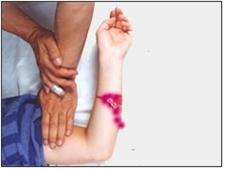
사진 201. 출혈될 때 나는 피를 공급하는 팔이나 다리 등에 있는 동맥을 손가락이나 손으로 꼭 눌러 지혈시킬 수 있다.
Copyright ⓒ 2012 John Sangwon Lee, MD., FAAP
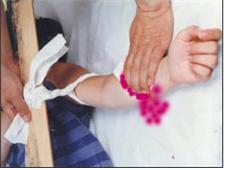
사진 202. 팔이나 다리에서 피가 많이 날 때는 피가 나는 상처 부분을 손으로 직접 꼭 눌러 지혈하고 그와 동시 출혈 부분에서 심장이 있는 쪽으로 조금 떨어진 팔이나 다리의 한 부분을 붕대나 지혈대 등으로 매어 지혈할 수 있다. 지혈대로 매서 지혈시키는 응급처치법은 다른 지혈 방법으로 지혈시킬 수 없는 응급한 경우에 쓰는 지혈 응급처치방법이다.
Copyright ⓒ 2012 John Sangwon Lee, MD., FAAP
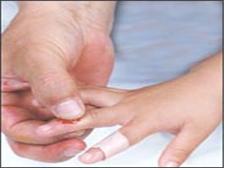
사진 204. 손가락이나 손으로 피나는 상처 부분을 직접 꼭 눌러 지혈시키거나 밴드를 붙이거나 붕대를 감아 지혈시킬 수 있다. Copyright ⓒ 2012 John Sangwon Lee, MD., FAAP
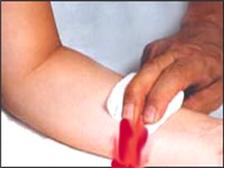
사진 205. 피가 나는 상처 부분을 손가락이나 손바닥으로 꼭 눌러 지혈시킬 수 있다
Copyright ⓒ 2012 John Sangwon Lee, MD., FAAP
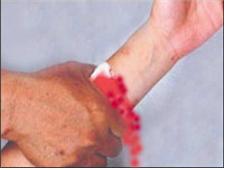
사진 206. 상처 부분에 거즈 등을 올려놓고 손바닥이나 손가락으로 상처를 직접 꼭 눌러 지혈시킬 수 있다
Copyright ⓒ 2012 John Sangwon Lee, MD., FAAP

사진 207. 상처에 거즈 등을 올려놓고 손으로 상처를 직접 꼭 눌러 지혈시킬 수 있다
Copyright ⓒ 2012 John Sangwon Lee, MD., FAAP
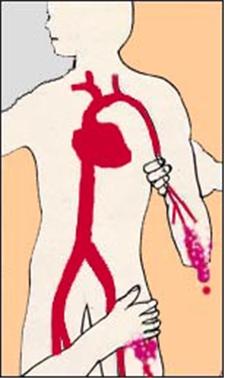
그림 210. 피나는 상처를 손가락 끝이나 손으로 직접 꼭 눌러 지혈시켜도 피가 계속 나면 출혈되는 피를 공급해 주는 동맥을 손으로 꼭 눌러 지혈할 수 있다.
Copyright ⓒ 2012 John Sangwon Lee, MD., FAAP
How to stop bleeding caused by various reasons 여러 종류의 출혈과 지혈 방법
• Bleeding/hemorrhaging is a few drops of external bleeding from the skin layer or subcutaneous.
• There are internal bleeding, external bleeding, or internal/external bleeding due to a cut in an artery or vein. • external bleeding from inside the body to outside the body,
• Or, internal bleeding from inside the body to the inside of the body around it.
• There are several types of bleeding, including acute bleeding and chronic bleeding.
• Depending on the type of bleeding, the method of stopping bleeding is very different. • Hereditary bleeding disorders such as hemophilia can cause bleeding.
• You may bleed more than normal when you have acquired, systemic, or bleeding diseases such as idiopathic thrombocytopenia purpura.
• If the bleeding exceeds normal, the bleeding should be delayed in an emergency and treated according to the cause. If bleeding occurs for any cause, hemostasis should be treated as an emergency first,
• CBC blood test, blood coagulation factor test, prothrombin time (PT), partial thromboplastin time (PTT), and bleeding time test may be needed to determine the cause (see Table 20).
• You may bleed your nose by pricking your nose with your fingers.
• At this time, it is common to stop bleeding by slightly holding the soft part of the nose (fly) with your thumb and finger.
• Or, in a hospital, two drops of adrenaline solution are put into the nostril (in the nasal cavity) in a cotton lump that usually stops bleeding.
• Otorhinolaryngology can sometimes treat capillaries in the nasal mucosa with silver acetate rods. • Thrombocytopenia, hemophilia, etc. can cause nosebleeds. At this time, hold the nose with two fingers as described above, stop bleeding, and receive follow-up treatment according to the doctor’s telephone consultation instructions.
• You may have nosebleeds after receiving tonsil surgery treatment or after receiving adenoid surgery treatment and may bleed in your mouth. At this time, it is also treated according to the doctor’s instructions.
• External bleeding caused by external trauma such as cuts, lacerations, torn wounds, tears, fissures, etc. depends on the size of the wound, body part, and the degree of bleeding. It can stop bleeding by compressing the bottom of the hand, or by suture surgery.

Picture 201. When bleeding I can stop bleeding by pressing the arteries in the arms or legs that supply blood with my fingers or hands. Copyright ⓒ 2012 John Sangwon Lee, MD., FAAP

Photo 202. When the arm or leg bleeds a lot, press the bleeding wound directly with your hand to stop bleeding, and at the same time, tie a part of the arm or leg slightly away from the bleeding area toward the heart with a bandage or tourniquet. It can stop bleeding. The first aid method of stopping bleeding with a tourniquet is a first aid method for hemostasis that is used in emergency cases that cannot be stopped with other hemostatic methods. Copyright ⓒ 2012 John Sangwon Lee, MD., FAAP

Picture 204. You can stop the bleeding by directly pressing the area of the bleeding wound with your finger or hand, or by attaching a band or bandage. Copyright ⓒ 2012 John Sangwon Lee, MD., FAAP

Picture 205. Hemostasis can be stopped by pressing the bleeding wound with a finger or palm. Copyright ⓒ 2012 John Sangwon Lee, MD., FAAP Picture 206. You can stop bleeding by putting gauze on the wound and pressing the wound directly with your palm or fingers. Copyright ⓒ 2012 John Sangwon Lee, MD., FAAP

Photo 207. You can stop bleeding by putting gauze on the wound and pressing the wound directly with your hand. Copyright ⓒ 2012 John Sangwon Lee, MD., FAAP

Fig. 210. Even if you press the bleeding wound directly with your fingertips or hand to stop bleeding, if the bleeding continues, you can stop bleeding by pressing the artery that supplies the bleeding blood with your hand. Copyright ⓒ 2012 John Sangwon Lee, MD., FAAP
출처 및 참조 문헌 Sources and references
- NelsonTextbook of Pediatrics 22ND Ed
- The Harriet Lane Handbook 22ND Ed
- Growth and development of the children
- Red Book 32nd Ed 2021-2024
- Neonatal Resuscitation, American Academy Pediatrics
-
Quick Reference to Pediatric Emergencies, Delmer J. Pascoe, M.D., p.75-76, 209-209
-
Emergency Pediatrics, A guide to ambulatory care, 5th edi. Roger M. Barkin, Peter Rosen, p.221-233
-
Emergency care and transportation of the sick and injured, 3rd edition, American Academy of orthopedic surgeons. p.18, 60-66, 117-118, 195-196
-
Nelson textbook, 14th edition, p.1273
-
Childhood Emergencies in the Office, Hospital and Community, American Academy of Pediatrics
-
Emergency Medical Service for Children, By Ross Lab. May 1989. p.10
-
Emergency care, Harvey grant and Robert Murray
-
Emergency Care Transportation of Sick and Injured American Academy of Orthopaedic Surgeons
-
Emergency Pediatrics A Guide to Ambulatory Care, Roger M. Barkin, Peter Rosen
-
Immediate care of the acutely ill and injured, Hugh E. Stephenson, Jr
-
The Critically Ill Child, Diagnosis and Management, Edited by Clement A. Smith
-
Emergency Medical Services for Children: The Role of the Primary Care Provider, America Academy of Pediatrics
-
Quick Reference To Pediatric Emergencies, Delmer J. Pascoe, M.D., Moses Grossman, M.D. with 26 contributors
-
Manual of Emergency Care
-
응급환자관리 정담미디어
-
소아가정간호백과–부모도 반의사가 되어야 한다, 이상원
-
Neonatal Resuscitation American heart Association
-
Neonatology Jeffrey J.Pomerance, C. Joan Richardson
-
Pediatric Resuscitation Pediatric Clinics of North America, Stephen M. Schexnayder, M.D.
-
Pediatric Critical Care, Pediatric Clinics of North America, James P. Orlowski, M.D.
-
Preparation for Birth. Beverly Savage and Dianna Smith
-
Nelson Textbook of Pediatrics 14th ed. Beherman,
-
The Johns Hopkins Hospital, The Harriet Lane Handbook, 18th edition
-
Red book 29th edition 2012
-
Nelson Text Book of Pediatrics 19th Edition
-
Infectious disease of children, Saul Krugman, Samuel L Katz, Ann A. Gershon, Catherine Wilfert
-
The Harriet Lane Handbook 19th Edition
-
소아과학 대한교과서
-
제1권 소아청소년 응급의료 참조문헌과 출처
-
Other
Copyright ⓒ 2015 John Sangwon Lee, MD., FAAP
“부모도 반의사가 되어야 한다”-내용은 여러분들의 의사로부터 얻은 정보와 진료를 대신할 수 없습니다.
“The information contained in this publication should not be used as a substitute for the medical care and advice of your doctor. There may be variations in treatment that your doctor may recommend based on individual facts and circumstances. “Parental education is the best medicine.”
http://www.pediatricinformationlosangeles.com/
부모도 반의사가 되어야 한다.
Google+